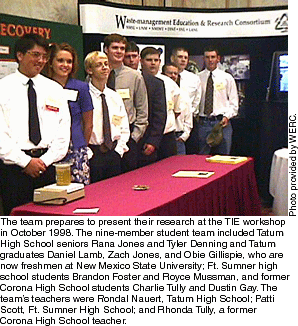

 High schoolers are awarded for their winning design High schoolers are awarded for their winning design
When nine high school students from Corona, Tatum, and Ft. Sumner put a Southeastern New Mexico team together to enter the 1998 environmental design contest sponsored by the Waste-management Education and Research Consortium (WERC), they had no idea they would have the opportunity to present their design at a U.S. Department of Energy meeting in Chicago. For the team that dubbed itself the Southeastern New Mexico Recovery Corporation, being named the overall winner among high school teams yielded $11,250 in cash for the respective schools, scholarships to New Mexico colleges, and an all-expense-paid trip to the Windy City. The student team tackled a real environmental cleanup problem facing a New Mexico mining company—identifying the best method to safely and economically remove copper mine tailings and relocating the tailings out of harm's way. “It was a great learning experience for everyone,” said former Tatum student Obie Gillispie. In late October 1998, the students and three of their teachers landed at Chicago's Midway Airport to begin three unforgettable days. During the first day, they were guests of Argonne National Laboratory for a tour of the laboratory and lunch in the private dining room. The next evening, the team presented its environmental design at the Tenth Technology Information Exchange (TIE) Workshop held for DOE employees and contractors. And the following day, the group toured Chicago. Tour arrangements, as well as the group's travel arrangements, were made possible by Sensible Environmental Solutions, a Grand Junction, Colorado–based nonprofit company that has long been involved with both the WERC design contest and the TIE workshops for DOE. Lawnie Taylor of DOE's Office of Environmental Restoration introduced the team members during the opening plenary session. Later, the team presented its environmental design and discussed its design for removing and relocating the copper mine tailings in an effective and environmentally safe manner. The students' design plan was thorough—they presented their method of extracting copper from tailings, its transportation by pumping the tailings in a slurry mixture to a lined pit, and many of the scientific, economic, regulatory, and community relations issues that affected their plan. Following the presentation, the students answered questions about their research. “The students analyzed the problem very well,” said Michael Ferrigan, technical program manager, Chicago Operations, DOE. “The opportunity for them to present their research is excellent; I wish I had had that opportunity as a high school student.” Carolyn Blackmore of Lockheed Martin Idaho Technologies Company said that the energetic can-do attitude of the students was very refreshing and added vitality to the conference as a whole. From the start of the project, the New Mexico team overcame obstacles by juggling after-school jobs, finding transportation home after staying late to work on their design, and traveling 250 miles between the schools for team meetings. Even forming a science team was a challenge because these rural Southeastern New Mexico schools have so few students. For example, Tatum's senior class numbered only 22, and Corona High School had only two students in the fall 1997 chemistry class. A new world of ideas “Having the opportunity to participate in a competition like the WERC Design Contest is a great learning experience for anyone,” said Obie Gillispie. “It opens your eyes to so many possible careers and gives you a perspective on what the world of industry is really like. This is especially true for high school students. Most students go to school every day and learn concepts that they don't relate to practical applications.” According to Tatum senior Rana Jones, the conference has helped expand her career options. “Presenting this [design concept] has given me a better idea of the available engineering ideas that are out there,” said Jones. |
| The WERC environmental design contest Founded in 1990 under a cooperative agreement with the U.S. Department of Energy, the Waste-management Education and Research Consortium (WERC) brings together New Mexico State University, the University of New Mexico, New Mexico Institute of Mining & Technology, Diné College, Sandia and Los Alamos National Laboratories, and industrial affiliates. The annual environmental design contest sponsored by WERC is a unique teaching method that is based on solving real-world environmental problems. The contest blends classroom courses, creativity, teamwork, hands-on experience, and months of preparation for both university/college and high school teams. In both competitions, teams are required to give an oral presentation, write a paper on their design, prepare a poster that describes their design, and build and operate a working bench-scale model of their design. Each of these four categories is reviewed and scored by judges from industry, academia, and government. Judging for the 1999 contest for college and high school teams is April 12–15 at New Mexico State University. Approximately 50 university teams and eight high school teams are participating in this year's contest. For more information on the contest, visit WERC's Web site , or call Alison Sawyer, WERC media specialist, at (800) 523-5996. |